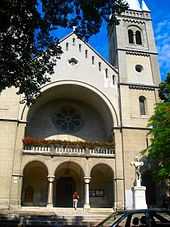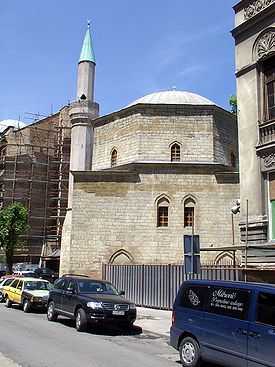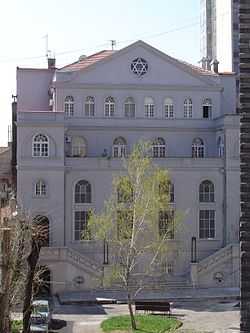Religion in Serbia

Serbia is a multi-religious country. The dominant religion is Eastern Christianity (predominantly the Serbian Orthodox Church). Other notable faiths include Islam (mainly in southern regions of Raška, Preševo, and Bujanovac, as well as in the disputed territory of Kosovo), Catholic Christianity (mainly in the northern part of the province of Vojvodina), and Protestantism. Serbia officially practises the separation of church and state.
Statistics
| 1921[2] | 1991 | 2002[3] | 2011 | |||||
|---|---|---|---|---|---|---|---|---|
| Number | % | Number | % | Number | % | Number | % | |
| Orthodox Christians | 3,321,090 | 75.85 | 6,347,026 | 81.8 | 6,371,584 | 84.98 | 6,079,396 | 84.59 |
| Roman Catholics | 751,429 | 17.16 | 496,226 | 6.4 | 410,976 | 5.48 | 356,957 | 4.97 |
| Muslims | 97,672 | 2.23 | 224,120 | 2.89 | 239,658 | 3.2 | 222,828 | 3.1 |
| Protestants | no data | no data | 88,275 | 1.14 | 80,837 | 1.08 | 71,284 | 0.99 |
| Jews | 26,464 | 0.6 | 740 | 0.01 | 785 | 0.01 | 578 | 0.01 |
| Greek Catholics | 16,859 | 0.39 | no data | no data | no data | no data | no data | no data |
| Total | 4,378,595 | 100 | 7,759,571 | 100 | 7,498,001 | 100 | 7,186,862 | 100 |
Christianity
Orthodoxy

Most of the citizens of Serbia are adherents of the Serbian Orthodox Church, while the Romanian Orthodox Church is also present in parts of Vojvodina inhabited by ethnic Romanian minority. Besides Serbs, other adherents of Orthodox Christianity include: Montenegrins, Romanians, Macedonians, Ukrainians, Bulgarians, Russians, Greeks, Vlachs and Romani, as well as one number of declared Yugoslavs and some Rusyns.
Orthodox Christianity is dominant in most of Serbia, excluding several municipalities and cities near border with neighboring countries where adherents of Islam or Catholic Christianity are more numerous as well as excluding two predominantly Protestant municipalities in Vojvodina and the territory of Kosovo, which is mostly populated by adherents of Islam. Orthodoxy also predominates in most of the large cities of Serbia, excluding the cities of Subotica (which is predominately Catholic) and Novi Pazar (which is predominately Muslim), as well as excluding large cities in Kosovo, all of which are predominately Muslim.
The identity of ethnic Serbs was historically largely based on Orthodox Christianity and on the Serbian Orthodox Church, to the extent of the claims that those who are not its faithful are not Serbs. However, the conversion of the south Slavs from paganism to Christianity took place before the Great Schism, the split between the Greek East and the Catholic West. After the Schism, those who lived under the Orthodox sphere of influence became Orthodox and those who lived under the Catholic sphere of influence became Catholic. Some ethnologists consider that the distinct Serb and Croat identities relate to religion rather than ethnicity. With the arrival of the Ottoman Empire, some Serbs and Croats converted to Islam. This was particularly, but not wholly, so in Bosnia. The best known Muslim Serb is probably either Mehmed Paša Sokolović or Meša Selimović. Since the second half of the 19th century, some Serbs converted to Protestantism, while historically some Serbs also were Catholics (especially in Dalmatia) or Greek Catholics.
Catholicism

Catholic Christianity is present mostly in the northern part of Vojvodina, notably in the municipalities with Hungarian ethnic majority (Bačka Topola, Mali Iđoš, Kanjiža, Senta, Ada, Čoka) and in the multi-ethnic city of Subotica and multi-ethnic municipality of Bečej. The ethnic groups whose members are mostly adherents of the Catholic Christianity are: Hungarians, Croats, Bunjevci, Germans, Slovenes, Czechs, Šokci, Poles, etc. A smaller number of Romani, Yugoslavs, and Slovaks are also adherents of the Catholic Christianity. In the disputed region of Kosovo, 10% of the Albanians are Catholic. The ethnic Rusyns and a smaller part of the ethnic Ukrainians are adherents of the Eastern Catholic Church.
Protestantism
The largest percentage of the Protestant Christians in Serbia on municipal level is in the municipalities of Bački Petrovac and Kovačica, where the absolute or relative majority of the population are ethnic Slovaks (most of whom are adherents of Protestant Christianity). Some members of other ethnic groups (especially Serbs in absolute terms and Hungarians and Germans in proportional terms) are also adherents of various forms of Protestant Christianity.

There are various neo-Protestant groups in the country, including Methodists, Seventh-day Adventists, Evangelical Baptists (Nazarene), and others. Many of these groups are situated in the culturally diverse province of Vojvodina. Prior to end of World War II number of Protestants in the region was larger.
According to the 2002 census, the largest Protestant communities were recorded in the municipalities of Kovačica (12,350) and Bački Petrovac (9,613), as well as in the second largest Serbian city Novi Sad (9,428), which is predominately Orthodox. While Protestants from Kovačica and Bački Petrovac are mostly Slovaks, services in most of the Protestant churches in Novi Sad are performed in the Serbian language.[4]
Protestantism (mostly in its Nazarene form) started to spread among Serbs in Vojvodina in the last decades of the 19th century. Although, percentage of Protestants among Serbs is not large, it is the only religious form besides Orthodoxy, which is today widely spread among Serbs.
Islam

Islam is mostly present in the southwest of Serbia in the region of Sandžak or Raška (notably in the city of Novi Pazar and municipalities of Tutin and Sjenica), in parts of southern Serbia (municipalities of Preševo and Bujanovac), as well as in the disputed region of Kosovo. Ethnic groups whose members are mostly adherents of Islam are: Bosniaks, Muslims by nationality, Albanians, Gorani, Turks, Arabs, Ashkali, and Egyptians. A small number of Romani are also adherents of Islam.
Adherents outside of Kosovo belong to one of the two following communities - Islamic Community of Serbia or the Islamic Community in Serbia. In Kosovo, there is a separate Islamic Community of Kosovo.
Judaism
As of 2002, there are 785 Jews in Serbia, mostly in the cities of Belgrade (415), Novi Sad (129), Subotica (89) and Pančevo (42).
Slavic Neopaganism
Slavic Neopaganism (Rodnovery in English; rodnoverje in Serbian) is a group of contemporary polytheistic, nativist and reconstructionistic religious groups reviving the ethnic religion of the Slavs. In 2011, in Serbian village of Mokra a group of enthusiasts, led by journalist Dragan Jovanović, erected a wooden statue of Svetovid.[5]
Irreligion
About 0.5% of Serbian population is atheist. Religiosity is lowest in Novi Beograd, with 3.5% of population being atheists (compare to whole Belgrade's and Novi Sad's 1.5%) and highest in rural places, where atheism in most municipacities goes below 0.01%.[6]
In a 2009 Gallup poll, 44% of respondents in Serbia answered 'no' to the question "Is religion an important part of your daily life?"[7]
Religious sites in Serbia
-

Đurđevi Stupovi Orthodox monastery, near Novi Pazar
-

Synagogue in Belgrade
-

Catholic Church in Bačka Topola
-

Eastern Catholic Church in Đurđevo
-

Mosque in Novi Pazar
See also
References
- ↑ Census 2011
- ↑ Demographic growth and ethnographic changes in Serbia
- ↑ Book 3 Page 13
- ↑ "??". Ehons.org. Retrieved 2013-10-07.
- ↑ "Kumir na Ravništu". Radio Television of Serbia. 2011-06-25.
- ↑ Book 3 Pages 13-16
- ↑ "Gallup Global Reports". Gallup.com. Retrieved 2013-10-07.
External links
| Wikimedia Commons has media related to Religion in Serbia. |
| ||||||||||||||
